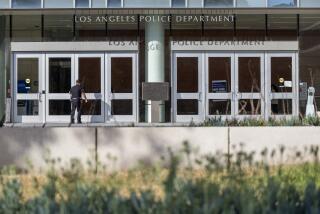L.A. Juries Don’t Mirror Populace, Official Says
- Share via
The official in charge of assembling jurors for Los Angeles courts said juries here do not adequately reflect community diversity.
“We are doing well in terms of (reflecting diversity) in race, gender and ethnicity,” said Raymond F. Arce, senior director of special operations for the Superior Court, “but not well with respect to age and economic status.”
Arce said the system is drawing more and more heavily from the ranks of the middle-aged and from the ranks of government, public utility and large manufacturing firms. He said it is drawing less heavily from the young and old, and from those who work in trades, as unskilled laborers, or for small firms.
The trend, the official said, is “a little bit frightening” in light of the long-standing public policy that jurors should reflect as many different points of view in the community as possible.
It is most evident in the longest trials, lasting half a year or more, where panels tend to be dominated by government employees--particularly, for reasons that are not clear, postal workers. In the Night Stalker case, for example, Arce said 24 jurors and alternates were selected and of them eight worked for the Postal Service, seven worked for other government agencies and four worked for utilities.
Arce said he fears that the trend toward loss of different perspectives could spread to more routine cases as the number of small employers who do not pay their employees for jury service grows.
The reason for the skewing in the longest trials is that government agencies and some of the largest firms pay employees their salaries for as long as a trial lasts. Most private firms won’t pay at all, however, and those that do typically pay for only up to 10 days--the traditional minimum length of jury service. Prospective jurors who say they cannot afford to serve on the $5 a day the county pays are routinely excused.
As a result, Arce said, “If it weren’t for the fact that . . . government, aerospace, insurance companies (and large manufacturers) . . . were . . . subsidizing the system, there would be a serious breakdown.”
Dominant Position
Arce said he fears that workers for these employers could also wind up dominating shorter, more routine trials as the percentage of the work force employed by large firms declines. The average trial in Los Angeles Municipal and Superior Courts lasts eight days.
Arce pointed to a survey completed this year for United Way, which found that smaller businesses--defined as those with less than 50 employees--now account for 95% of all businesses in Los Angeles.
“As a rule,” Arce said, “businesses with less than 50 employees do not provide employees with (paid) jury service leave.”
In addition, Arce said that paid jury service benefits “disappeared long ago from many collective bargaining agreements,” resulting in financial harships for prospective jurors drawn from ranks of organized labor.
Lost in Trade-Offs
He said these benefits were generally eliminated in return for wage hikes, and that because courts have been widely viewed as “insensitive” in making good use of juror time, there has been no rush to try to win them back.
People with menial jobs--such as washing cars or busing tables--rarely show up, he said.
Arce said that “unless we devise some sort of plan for making sure that all areas participate . . . it’s going to be an exclusive group that is serving.”
He said possibile solutions include legislation that would require employers to pay workers while they serve on juries, or creation of a public fund to pay them.
More to Read
Sign up for Essential California
The most important California stories and recommendations in your inbox every morning.
You may occasionally receive promotional content from the Los Angeles Times.










